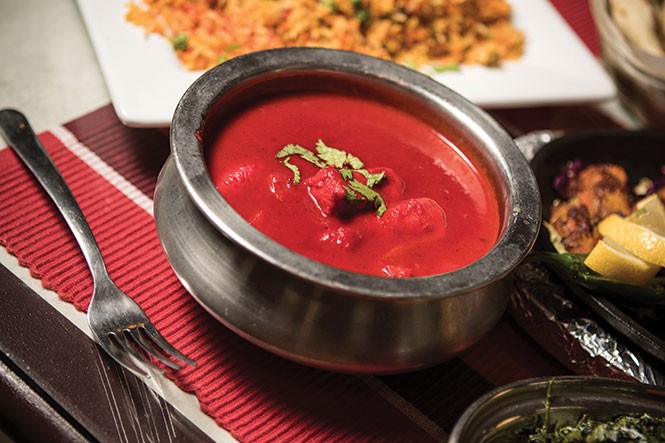
For a long time, my go-to Indian restaurant was Taste of India, in Layton. However, the original owners sold the business and moved to Texas a while back, and I'm sorry to report that the cook must have left with them. However, I recently made a new Northern Indian restaurant discovery ("Northern" meaning north of Salt Lake City, not necessarily cuisine representing the North of India): Sitara India restaurant in Ogden. Up until mid-January, there was another Sitara location—in Layton. Unfortunately, that eatery—which had more ambiance appeal than the Ogden one—has closed temporarily while the owners look for new digs. The owners promise to "be back very soon."
A quick Google search informs me that sitara is a Sanskrit word meaning "the morning star." The "morning" part notwithstanding, there isn't any breakfast to be had at Sitara. However, Sitara offers an inexpensive, all-you-can-eat lunch buffet ($7.99) that is of better overall quality and selection than most Indian lunch buffets I've previously encountered. The choices change frequently, and I noticed is that at least half of their lunch buffet dishes were vegetarian—a nice option for non-meat eaters.
Although I can't say I'm a big fan of buffets in general, I do think they serve an important purpose, especially at Indian restaurants. They provide customers who might not be too familiar with Indian/Pakistani cuisines a number of different dishes, with little economic downside. At Sitara, you can always count on some staples such as basmati rice and naan—leavened white flour bread similar to pita, baked in a tandoori oven—as well as raita and gulab jamun to appear at the lunch buffet. Raita is a popular side dish in Pakistan, India and Bangladesh: yogurt mixed with tomato, onion, carrot and spices such as cumin and black mustard. It's a cooling condiment/side dish that can help tone down the incendiary after-burn of a spicy dish like Sitara's lunchtime beef curry. As for gulab jamun, it is a common dessert in Indian restaurants in which milk solids are kneaded with wheat flour into small balls, deep-fried and served in a light sugar syrup, usually flavored with cardamom and rose water.
One of the more complex dishes I enjoyed at Sitara's buffet lunch was navratan korma. The translation of the dish into English is "nine gem curry." And indeed, it's composed of nine different types of vegetables, dried fruits and nuts, all bathed in a rich, creamy coconut milk curry that is irresistible. It's also available on the regular menu for $8.25, including basmati rice or naan.
I can't say that Ogden's Sitara India has much eye appeal. However, the service is super-friendly at this hole-in-the-wall eatery, if a bit slow when things get busy. The place is often mobbed at lunchtime on weekdays for the all-you-can-eat buffet. I'm sometimes encouraged, however, when dishes emerge slowly from the kitchen during regular service, because it tells me the food is being made-to-order, from scratch, not just sitting in heating units à la the buffet.
I like to begin a Sitara meal with an order of papadam ($1.25), a pair of crispy, thin wafers made from lentil flour, beautifully charred in the tandoori oven and spiked with cumin seeds, served with tamarind and mint chutneys alongside. Another great bread item—one that could serve as a shared appetizer or as a filling main dish—is puri and chana masala ($7.99), a very popular dish in Southern India. The puri is two pieces of puffy, deep-fried unleavened Indian bread, served with a generous portion of chana masala: tender chickpeas in a thick yellow-orange curry with hints of onion, tomato, cardamom, coriander, cumin, fennel, cinnamon, grated coconut and more. If you have leftovers, the chana masala is also delicious when reheated.
Two dishes from the menu's "Seafood Specialties" were both excellent. First, tender shrimp and fresh spinach cooked in a tangy tomato and onion gravy (shrimp saag) was delightful, and nicely priced at a mere $9.50. A seafood house specialty is a generous serving of tawa fried fish ($10.99). A tawa (also called a tava) is a large, flat, circular cooking pan made for frying; it would be ideal for making pancakes and crepes. At Sitara, the tawa is used to cook up a generous batch of tilapia fillets which are marinated first in a mélange of Indian spices, then flash-fried with onions and yellow peppers, served sizzling hot on the tawa, garnished with minced cilantro.
I could tell by the nearly neon-red color of my lamb vindaloo ($9.50) that it was going to be fiery. After all, that's the way I'd ordered it. Curry dishes at Sitara can be ordered in mild, medium or hot versions, but vindaloo is almost always hot and spicy right off the bat. Still, I ordered the hot version; what can I say, I'm a chili-head. Originating in the Indian region of Goa, vindaloo is a type of curry that incorporates vinegar (usually palm vinegar) with red Kashmiri chili peppers as main components. Peeled chunks of potato are also usually part of any vindaloo preparation. Sitara's lamb vindaloo is outstanding: tender, boneless bite-size pieces of lamb is cooked in the house vindaloo sauce with cumin seeds, red chili peppers, cinnamon and cloves, served in the sauce with pieces of potato. The other dish I enjoyed almost as much as the vindaloo was the chicken korma ($8.99), soft, boneless pieces of chicken in a mild, but memorable, sauce of cashew nuts, onion paste and cream.
If you're on the hunt for authentic Indian flavors in Weber County, Sitara certainly satisfies. CW